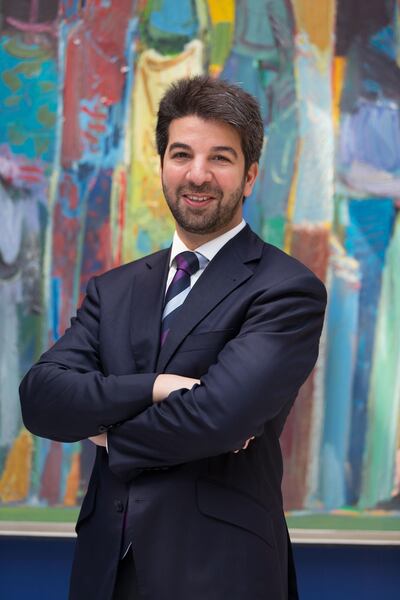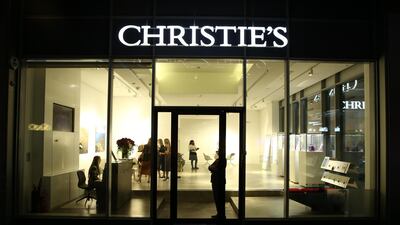Christie's is reducing the number of sales it holds for Middle Eastern, Modern and Contemporary Art. The auction house will only be holding one sale a year, down from its previous two sales annually.. It will forego the biannual Dubai and London schedule it formerly followed, and drop its usual Dubai spring sale this year, in favour of one overall sale in London in the autumn.
"We have our pulse on the market," says Caroline Louca-Kirkland, the new managing director for the Middle East at Christie's. "There's no point in having two sales if the market is not hungry for it. It's best to cater to the needs of the collectors."
Next year, the auction house will hold its Middle Eastern art sale in Dubai in the spring, along with its watches sale, but will again only hold one sale.
What does this say about the Middle East art market?
There's no denying that the number of auctions being held has been scaled back from when Christie's first began selling in Dubai, in 2005. "In the early years, when we first started selling that category [Middle Eastern art], there was a lot of indiscriminate buying taking place, and collectors were buying a large number of works across the board," says Michael Jeha, chairman, Christie's Middle East.
"Over time we’ve seen the market mature and collectors know exactly what they want now. They are focusing on a narrow group of artists."

The supply side has equally changed, partly due to the success of the auction houses and the market in general. Most works by major Modern Arab artists havegone into the collections of serious individuals and institutions – including some that didn't exist 15 years ago, such as Louvre Abu Dhabi and Barjeel Art Foundation in the UAE – and are simply no longer on the market.
"The supply of top-quality Modern art is becoming thinner," says Jeha. "In the last 15 years we've seen a lot of great works go to institutions and collectors who have no intention to resell."
At the same time, he says, demand for Middle Eastern work is increasingly coming from buyers around the world. "More and more collectors and institutions globally are buying Middle East art, and having a sale in London helps to internationalise the market."
This autumn's will be the fourth Middle Eastern sale held in the British capital. In line with the increased global profile of Middle Eastern work, Christie's now puts more of the region's art in to its Post-War and Contemporary sale, which — despite its lack of explicit geographical specification — mostly incorporates US and European work.
Last October, for example, the London Post-War sale achieved an artist's record forLebanese painter Huguette Caland, with the sale of a painting in her Bribes de Corps (Body Parts) series, from the collection of Eric Clapton, for £250,000.

More broadly, of course, the scale-down at Christie's reflects the current climate in the Middle East. The Dubai economy is recovering from a fall in trade, and political worries such as the unrest in Lebanon, the protests in Iraq, and regional fears over the power struggle between Iran and the US, have dampened confidence. Though Jeha and others selling in the region brush off the idea that the art market has been vastly affected by the political instability, the mood seems to be one of allaying fears over worst-case scenarios, rather than insisting that all is rosy.
The Lebanese banking crisis, for example, does only affect those Lebanese collectors who do not have access to international accounts from which to withdraw their money — that is, a few will be impacted, but not all. That's still not good for business.
The feeling in Dubai is similar. Gallerists remain committed to their artists, despite a general consensus that the free-flowing early days of the 2000s are gone for good. The new normal is a slower but steadier market.
"We can certainly fear that the geopolitical situation in the region will have an impact on the art market, but from another side, we remain confident in the stability of the UAE," says Isabelle Van Den Eynde, whose eponymous Alserkal Avenue gallery in Dubai has been going since 2010. "There have been a number of regional crises in the last few years, since the launch of Art Dubai, and each time the art collectors show up. And when the international ones do not come in large numbers, local ones - Saudis, Kuwaitis, Iranians - compensate."
In Dubai, the trend towards a consolidation of the primary market in Alserkal Avenue continues. Van Den Eynde recently signed Manal Al Dowayan, an established Saudi Arabian artist, who showed with Cuadro in DIFC until three years ago. Lawrie Shabibi in Alsrkal Avenue, Dubai, has signed up two older regional artists: Mohammed Ahmed Ibrahim, who was also formerly at Cuadro, and Mohamed Melehi, the pioneering Moroccan artist whose works will be displayed in a solo show at Concrete in Alserkal Avenue in March. Generally speaking, this means these artists will have a better conduit into major museum collections. For the galleries, they are in effect creating deeper benches.
Christie's, which is the market leader in the Middle East, also underlines that it is simply shifting its presence in the region towards meeting the different needs of its collectors, seeking to grow the modern market by other means. It has recently refurbished its offices in DIFC to include space for exhibitions and talks, and it is becoming more active in Saudi Arabia, hosting private exhibitions and charity sales, such as the one it held last year in Jeddah.
The auction house also point out the benefits of a more mature market. “More and more artists’ estates being set up, and more and more literature, and catalogue raisonnes, are being produced, so for more Middle Eastern artists, now there is someone to refer to,” says Jeha. “Processes are becoming more sophisticated.”


